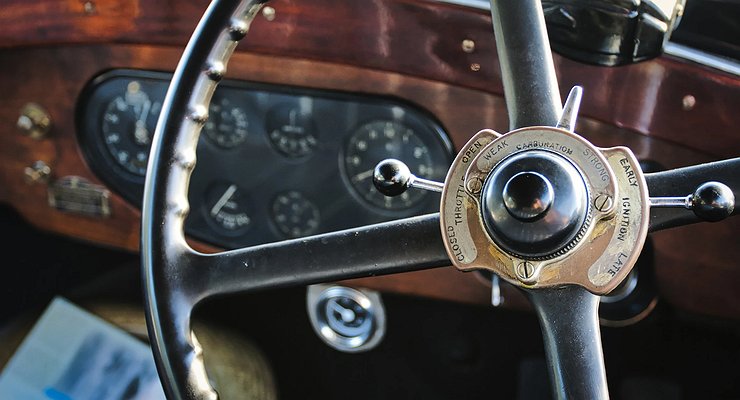Why most drivers don’t know how to properly turn the steering wheel
- December 2, 2022
- 0
Alas and ah, but no practical, modern driver driving a car does it right. The AvtoVzglyad portal will try to remedy the situation by offering a small refresher
Alas and ah, but no practical, modern driver driving a car does it right. The AvtoVzglyad portal will try to remedy the situation by offering a small refresher

So we always hold the steering wheel with both hands, on points 10-2 or 9-3. Only the “closed” grip type is allowed. You can not squeeze the steering wheel hard and strain the muscles of the shoulder girdle: this will negatively affect the ride quality. When turning the wheel, each hand performs its own task: the leading one is responsible for the speed of turning the steering wheel, and the driven one is responsible for its accuracy. The allowed steering speed depends on the adhesion coefficient of the wheels to the road and the speed of the vehicle. And in emergency situations it is necessary to be able to use the technique of “interceptions”.
Very often, in relation to a person driving a car, we use the verb “steer”. And not just like that, because it is up to the interaction with this, for the most part a round object, that we put the most effort into. The question arises: how to use the steering wheel correctly to improve the quality of interaction with the vehicle? Let’s try to figure it out.
The task of the steering wheel is to change the direction of the car. During the maneuver, the car is the most difficult to control. After all, a large number of disturbing factors are acting on the machine at the moment. This means that the driver must also be able to turn the steering wheel correctly, not only from the point of view of the logic of the maneuver performed, but also to perform this action technically correctly.
Despite the fact that the steering wheel is round, this does not mean at all that you can hold it the way you want. Properly use a symmetrical, two-handed grip. At the same time, we repeat, it is advisable to keep the steering wheel at points 10−2 or 9−3 (by analogy with the location of the numbers on the dial of an analog clock). The symmetrical handle allows you to turn the steering wheel both to the right and to the left with the same amplitude.
In addition, it reduces fatigue during long journeys. There is one more important point. We hold the steering wheel with a “closed” handle. That is, the palm wraps around the steering wheel rim from the outside, and the thumb closes the grip from the inside. This significantly increases the reliability of contact with the steering wheel.
When turning the wheel, we must know that each of the hands performs its task. In left turns, the left should work more actively, play a leading role and engage the flexors. The judge becomes helper and makes a pushing movement. On right turns, their roles change. In addition, if the leading hand is responsible for the speed and amplitude of the steering wheel, then the assisting or driven hand is responsible for the accuracy. Another important point is speed. Is it possible to turn the steering wheel to the desired angle very quickly? Or should you use slow and gentle movements?
It all depends on the current conditions and speed of movement. The lower the traction coefficient, the smoother we turn the wheel. Otherwise, we risk slipping the front wheels and the car will go into loss of control mode. The same applies to the driving speed. The higher it is, the “softer” the hands work, since the front wheels will process a huge amount of kinetic energy accumulated by the car. As long as the steering wheel turns a small angle, everything is simple. Hands don’t come off the wheel and it’s very easy to operate. However, if the amplitude grows, you will be forced to tear them from the “rudder”.
In this case, the interception technique is used. For example, when in a right turn, the right hand, turning the steering wheel, is at point 5, we open the grip. Then the hand is transferred to point 11 by the shortest route, so that the grip at point 12 is already closed. While the right hand is transferred, the left, without losing contact with the steering wheel, continues to turn it. And when she gets to point 5, the transfer process is repeated on her.
This technique is quite complicated, but it allows you to maintain constant and reliable contact with the steering wheel. However, most turns on real roads can be negotiated without taking your hands off. And steering with interceptions, as a rule, is only necessary in emergency situations, when the driver tries to react to, for example, a slip of the steering wheel. Or while parking.


So we always hold the steering wheel with both hands, on points 10-2 or 9-3. Only the “closed” grip type is allowed. You can not squeeze the steering wheel hard and strain the muscles of the shoulder girdle: this will negatively affect the ride quality. When turning the wheel, each hand performs its own task: the leading one is responsible for the speed of turning the steering wheel, and the driven one is responsible for its accuracy. The allowed steering speed depends on the adhesion coefficient of the wheels to the road and the speed of the vehicle. And in emergency situations it is necessary to be able to use the technique of “interceptions”.
Very often, in relation to a person driving a car, we use the verb “steer”. And not just like that, because it is up to the interaction with this, for the most part a round object, that we put the most effort into. The question arises: how to use the steering wheel correctly to improve the quality of interaction with the vehicle? Let’s try to figure it out.
The task of the steering wheel is to change the direction of the car. During the maneuver, the car is the most difficult to control. After all, a large number of disturbing factors are acting on the machine at the moment. This means that the driver must also be able to turn the steering wheel correctly, not only from the point of view of the logic of the maneuver performed, but also to perform this action technically correctly.
Despite the fact that the steering wheel is round, this does not mean at all that you can hold it the way you want. Properly use a symmetrical, two-handed grip. At the same time, we repeat, it is advisable to keep the steering wheel at points 10−2 or 9−3 (by analogy with the location of the numbers on the dial of an analog clock). The symmetrical handle allows you to turn the steering wheel both to the right and to the left with the same amplitude.
In addition, it reduces fatigue during long journeys. There is one more important point. We hold the steering wheel with a “closed” handle. That is, the palm wraps around the steering wheel rim from the outside, and the thumb closes the grip from the inside. This significantly increases the reliability of contact with the steering wheel.
When turning the wheel, we must know that each of the hands performs its task. In left turns, the left should work more actively, play a leading role and engage the flexors. The judge becomes helper and makes a pushing movement. On right turns, their roles change. In addition, if the leading hand is responsible for the speed and amplitude of the steering wheel, then the assisting or driven hand is responsible for the accuracy. Another important point is speed. Is it possible to turn the steering wheel to the desired angle very quickly? Or should you use slow and gentle movements?
It all depends on the current conditions and speed of movement. The lower the traction coefficient, the smoother we turn the wheel. Otherwise, we risk slipping the front wheels and the car will go into loss of control mode. The same applies to the driving speed. The higher it is, the “softer” the hands work, since the front wheels will process a huge amount of kinetic energy accumulated by the car. As long as the steering wheel turns a small angle, everything is simple. Hands don’t come off the wheel and it’s very easy to operate. However, if the amplitude grows, you will be forced to tear them from the “rudder”.
In this case, the interception technique is used. For example, when in a right turn, the right hand, turning the steering wheel, is at point 5, we open the grip. Then the hand is transferred to point 11 by the shortest route, so that the grip at point 12 is already closed. While the right hand is transferred, the left, without losing contact with the steering wheel, continues to turn it. And when she gets to point 5, the transfer process is repeated on her.
This technique is quite complicated, but it allows you to maintain constant and reliable contact with the steering wheel. However, most turns on real roads can be negotiated without taking your hands off. And steering with interceptions, as a rule, is only necessary in emergency situations, when the driver tries to react to, for example, a slip of the steering wheel. Or while parking.
Source: Avto Vzglyad
Donald Salinas is an experienced automobile journalist and writer for Div Bracket. He brings his readers the latest news and developments from the world of automobiles, offering a unique and knowledgeable perspective on the latest trends and innovations in the automotive industry.